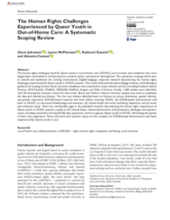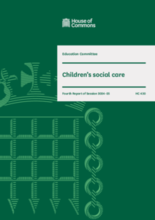Displaying 11 - 20 of 2214
This study explores how trust is built within the Mockingbird Family foster care model in Australia, based on interviews with children, carers, and care networks. Findings show that trust emerges through daily interactions, collaboration, and organizational and political support, rather than being a fixed trait. The study highlights the importance of relationship-centered, interconnected approaches to reimagining foster care.
Foster care is the preferred out-of-home placement for children at risk. However, the number of children in child protection systems exceeds the availability of foster families, highlighting the need for recruitment campaigns. Despite the growing development of such campaigns, their results have not been evaluated. This study aimed to design and experimentally evaluate messages to increase awareness, willingness, and intention to foster in Portugal.
This paper examines the benefits of foster care by exploring the experiences of foster care leavers and the perspectives of social workers in Tshwane District Municipality, Gauteng Province, South Africa. The findings highlight that foster care placements provide foster care leavers with essential support, including basic necessities, a family-like environment, improved relationships, independence, recreational opportunities, poverty reduction, therapeutic support, and educational benefits.
The human rights challenges faced by Queer youth in out-of-home care (OOHC), such as foster and residential care, have largely been overlooked in child protection research, policy, and practice development. This systematic scoping review aims to identify and synthesize the existing international, English-language, empirical research documenting the human rights challenges experienced by Queer youth in OOHC systems.
A randomized controlled trial examined the effectiveness of a peer grief support program for youth in foster care, an underrepresented population who experience disenfranchised grief.
This consensus statement on youth in foster care makes a case for a developmentally informed system of care. Although it avoids making specific policy and practice recommendations, it identifies general areas where research can inform change.
This study explores the experiences and challenges of caregivers providing trauma-informed care to foster children in a South African care facility. Findings highlight the emotional and practical difficulties faced by caregivers and emphasize the need for targeted training and support to strengthen their capacity and well-being.
This report makes a series of recommendations on issues affecting all types of care, including foster care, adoption, kinship care, children’s homes, and support for disabled children in the UK.
This position paper examines how stigma shapes reproductive health, poverty alleviation, and child welfare, influencing policy, service provision, and lived experiences. It argues that stigma is a structural barrier that worsens inequalities and calls for a cross-sectoral, lived experience–informed approach to reduce exclusion and improve outcomes.
This study analyzes how Omani law protects vulnerable children without family care through foster arrangements, comparing it with practices in Morocco, the UAE, and the principles of Islamic Sharia law. While Oman’s legal framework provides a foundation for care, the research highlights weaknesses in implementation and oversight, recommending stronger monitoring, greater community involvement, and closer alignment with both regional best practices and Sharia objectives.






